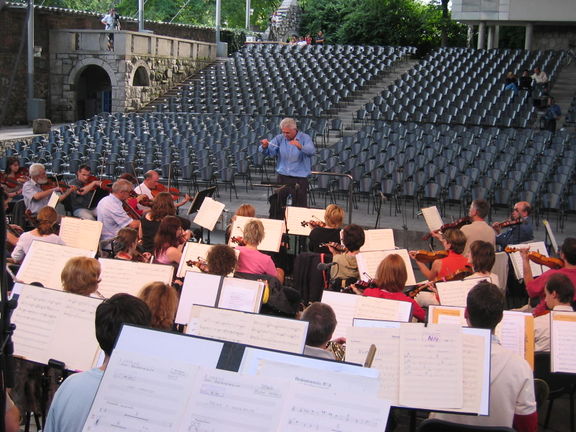Difference between revisions of "Križanke"
(imported from XML by extractor/importer) |
(imported from XML by extractor/importer) |
||
| Line 28: | Line 28: | ||
Jože Plečnik's last great contribution to the city transformed the abandoned monastery into an open-air theatre and festival space. The complex's original Gothic details were gradually subsumed by Renaissance and Baroque elements, as can be clearly seen in the main courtyard which features shallow archways and exuberantly-coloured graffiti. The amphitheatre-like southern courtyard with its vast retractable canopy has since proved to be a superb venue for classical, jazz and rock concerts. | Jože Plečnik's last great contribution to the city transformed the abandoned monastery into an open-air theatre and festival space. The complex's original Gothic details were gradually subsumed by Renaissance and Baroque elements, as can be clearly seen in the main courtyard which features shallow archways and exuberantly-coloured graffiti. The amphitheatre-like southern courtyard with its vast retractable canopy has since proved to be a superb venue for classical, jazz and rock concerts. | ||
| − | + | [[Category:Monuments and sites]] | |
[[Category:Theatre venues]] | [[Category:Theatre venues]] | ||
Revision as of 01:42, 18 November 2009
Križanke continued to serve as a monastery until 1945, when the complex was nationalised. In 1952 representatives of the city of Ljubljana asked architect Jože Plečnik to remodel the now derelict monastery into a venue for Ljubljana Festival.
Jože Plečnik's last great contribution to the city transformed the abandoned monastery into an open-air theatre and festival space. The complex's original Gothic details were gradually subsumed by Renaissance and Baroque elements, as can be clearly seen in the main courtyard which features shallow archways and exuberantly-coloured graffiti. The amphitheatre-like southern courtyard with its vast retractable canopy has since proved to be a superb venue for classical, jazz and rock concerts.



